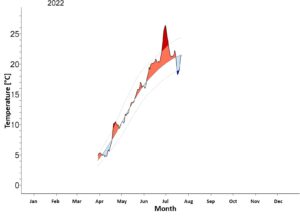11.8.2022
Historically intense marine heat waves were recorded in June in Åland
In late June and early July (26 June–4 July, 2022), a marine heat wave lasting nine days was observed in Åland, at the Husö Biological Station of Åbo Akademi University. This is the third consecutive year when seawater temperature has been exceptionally high in June.
The mean intensity of the marine heat wave was 4.9 °C over the normal and the maximal intensity exceeded the normal by 6.4 °C. Both mean and maximal intensities were historically high in the time series that started 17 years ago.
“Another noteworthy aspect is that, on 30 June 2022, a new heat record was observed at the Husö field station. The seawater temperature rose to 27.65 °C. Earlier, top recordings have occurred in late July or August”, explains Lucinda Kraufvelin, PhD student at Åbo Akademi University, with special interest in global change and extreme events.
A marine heat wave is defined as a period of five or more consecutive days during which the seawater temperature exceeds the 90th percentile (the upper dotted line in grey in the figure). This value is determined from local climatology, which usually is based on a time series of a minimum of 30 years of temperature data. At the Husö Biological Station, seawater temperatures have been recorded by means of a logger placed off the pier, in the depth of about one metre, every other hour throughout the ice-free season since the year 2005. The recording data thus ranges over 17 years.
In line with global measurements, other longitudinal data from Åland, with a time span of around 30 years, show a generally rising trend in seawater temperatures. In 30-year time series, the recording frequency is considerably lower (1–2 times a week) than in the recordings for monitoring marine heat waves (once every other hour). Based on the high-frequency recordings carried out since 2005, the following significant events linked with the rising temperatures have been observed over the past four years:
- The years with most marine heat waves (2018 and 2020)
- The year with the longest uninterrupted marine heat wave (2021)
- The marine heat wave with the highest mean and maximal intensities (2022)
- The highest recorded temperature (2022).
“Seawater temperatures in June, in particular, have been exceptionally high in three years in a row. These warm periods in June have been followed by a cooler period in high summer, which used to be the warmest season”, says Christian Pansch-Hattich, Associate Professor in Environmental and Marine Biology at Åbo Akademi University.
The periods with extreme water temperatures affect everything below the surface. The effects are most tangible for those species that cannot escape the heat. It has already been observed, for example, that bladder wrack ceases to photosynthesise when the temperature is higher than normal, and will eventually break down if the temperature is unusually high for several days in a row. At the same time, the higher temperatures are favourable for the fast-growing annual thread algae, which live on, for example, bladder wrack. This is problematic since the elevated water temperatures may also eliminate small crustaceans that feed on thread algae. If the thread algae can grow freely, it may completely cover and suffocate the bladder wrack.
Many important species living on the bottom of the Baltic Sea (such as bivalves and polychaete worms) suffer from the heat. When the temperature rises higher than normal, the bottom fauna will stiffen.
“If the temperature is too high for a longer period of time, say, for a week, many of the bottom fauna species will die. As a result, the bottom sediment is no longer effectively oxidized, which leads to oxygen deficiency and the leaking of phosphorus bound in the sediment to the water. Phosphorus is known to contribute to the eutrophication of the Baltic Sea, with consequences such as increased algal blooms”, says Tony Cederberg, Manager at the Husö Biological Station.
Globally, the Baltic Sea is one of the marine regions where the surface water temperature is currently rising fastest. Over the past 30 years, the temperature of the Baltic Sea has risen by two degrees on average. Rising temperature is a major driving force underlying the increased frequency of marine heat waves and, accompanied with the duration and intensity of the heat waves, it will probably have an even more significant impact on the Baltic Sea in the future.

For more information, please contact:
Lucinda Kraufvelin
PhD student, with special interest in global change and extreme events, Åbo Akademi University
Email: lucinda.kraufvelin@abo.fi
Phone: +358 40 353 0040
Christian Pansch-Hattich
Associate Professor, Environmental and Marine Biology, Åbo Akademi University
Email: christian.pansch-hattich@abo.fi
Phone: +358 50 512 6850
Tony Cederberg
Manager, Husö Biological Station, Åbo Akademi University
Email: tony.cederberg@abo.fi Phone
